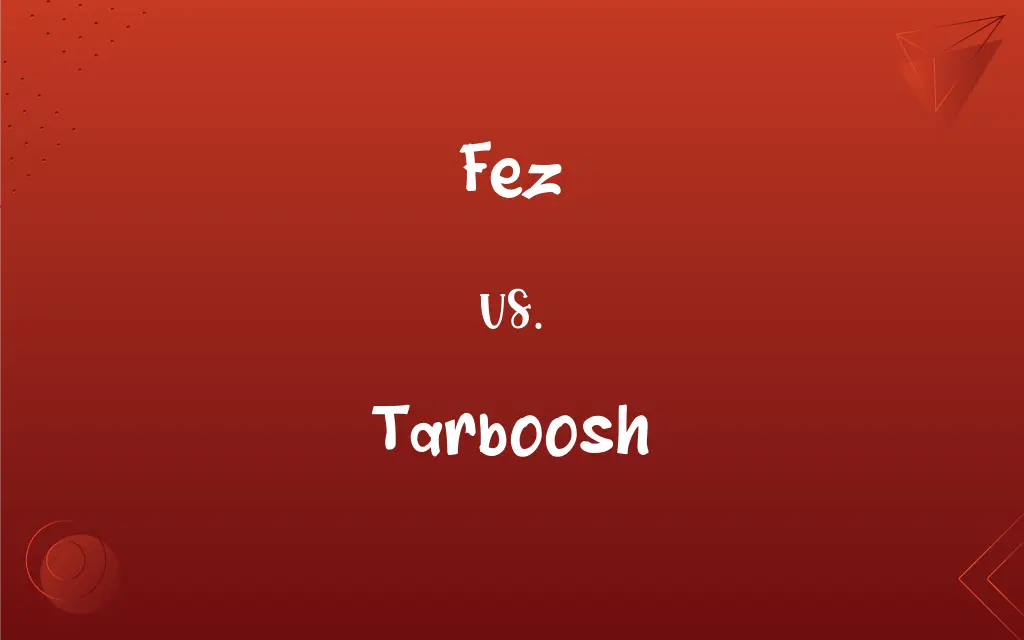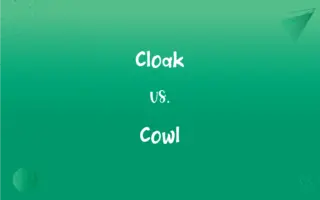Fez vs. Tarboosh: What's the Difference?
By Harlon Moss & Janet White || Updated on May 23, 2024
A fez is a felt hat shaped like a truncated cone, often red, with a tassel, mainly associated with the Ottoman Empire. A tarboosh is a similar hat, also conical and tasselled, worn in North Africa and the Middle East.

Key Differences
A fez is a type of hat that originated in the Ottoman Empire, notable for its truncated cone shape and red felt material. It typically features a long black tassel. The fez is primarily associated with the cultural and historical traditions of Turkey. A tarboosh, on the other hand, is similar in shape and style to the fez, being conical and often adorned with a tassel. However, the tarboosh is more commonly linked with North Africa and parts of the Middle East, such as Egypt and Morocco.
While both hats share a similar design, the fez is more closely related to Ottoman traditions, whereas the tarboosh is part of a broader regional costume in North Africa and the Middle East. The fez's significance is largely tied to the Ottoman Empire, reflecting its historical and cultural influences.
The tarboosh, while similar in appearance, has a more varied cultural background, symbolizing different aspects of identity in various countries. Both hats are made from similar materials, primarily red felt, but their cultural connotations differ.
In modern times, the fez has become more of a cultural symbol and is often worn in traditional ceremonies. The tarboosh, meanwhile, continues to be worn in some regions as a symbol of cultural heritage.
While the fez and tarboosh are often used interchangeably in casual conversation, their historical and cultural contexts provide distinct identities to each hat. Understanding these differences is crucial for appreciating their respective roles in cultural traditions.
ADVERTISEMENT
Comparison Chart
Origin
Ottoman Empire
North Africa and Middle East
Shape
Truncated cone
Conical
Material
Red felt
Red felt
Cultural Association
Ottoman cultural heritage
Regional identity in North Africa and the Middle East
Modern Usage
Traditional ceremonies
Cultural heritage symbol
ADVERTISEMENT
Fez and Tarboosh Definitions
Fez
A red felt hat in the shape of a truncated cone.
The dignitary wore a fez during the official ceremony.
Tarboosh
A cultural symbol in Egypt and surrounding regions.
The old photograph depicted men in tarbooshes at a market in Cairo.
Fez
A cultural symbol of the Ottoman Empire.
The photograph showed men wearing fezzes in early 20th century Istanbul.
Tarboosh
A conical red felt hat worn in North Africa and the Middle East.
The man adjusted his tarboosh before entering the mosque.
Fez
A traditional Ottoman hat with a black tassel.
The museum displayed an Ottoman fez in its historical clothing section.
Tarboosh
A hat often accompanied by a tassel.
His tarboosh had a long tassel that swayed as he walked.
Fez
A hat associated with Turkish traditions.
He bought a fez as a souvenir from his trip to Turkey.
Tarboosh
A part of traditional dress in many Middle Eastern countries.
The dancers wore tarbooshes as part of their performance costume.
Fez
A ceremonial hat in modern Turkey.
The fez was part of the official dress at the cultural festival.
Tarboosh
A traditional hat similar to the fez but with broader regional usage.
The tarboosh is often seen in Moroccan celebrations.
Fez
A man's brimless felt cap in the shape of a flat-topped cone, usually colored red and adorned with a silk tassel, once widely worn in the Ottoman Empire and other regions with Muslim populations and still worn today in some Muslim countries. Also called tarboosh.
Tarboosh
See fez.
Fez
A felt hat in the shape of a truncated cone, having a flat top with a tassel attached.
Tarboosh
A red felt or cloth cap with a tassel, worn in the Arab world; a fez.
Fez
A felt or cloth cap, usually red and having a tassel, - a variety of the tarboosh. See Tarboosh.
Tarboosh
A red cap worn by Turks and other Eastern nations, sometimes alone and sometimes swathed with linen or other stuff to make a turban. See Fez.
Fez
A city in north central Morocco; religious center
Tarboosh
A felt cap (usually red) for a man; shaped like a flat-topped cone with a tassel that hangs from the crown
Fez
A felt cap (usually red) for a man; shaped like a flat-topped cone with a tassel that hangs from the crown
FAQs
Are fezzes and tarbooshes made from the same material?
Yes, both are typically made from red felt.
What is the primary difference between a fez and a tarboosh?
A fez is associated with the Ottoman Empire, whereas a tarboosh is linked to North Africa and the Middle East.
Do fezzes and tarbooshes have the same shape?
Both are conical, but the fez has a more truncated cone shape.
Where is the fez most commonly associated with?
The fez is most commonly associated with Turkey and the Ottoman Empire.
What does wearing a tarboosh signify in contemporary society?
Wearing a tarboosh can signify cultural pride and heritage.
Does the tarboosh have any religious significance?
The tarboosh itself is not inherently religious but can be worn during religious ceremonies in some cultures.
Can a tarboosh be worn casually?
Yes, in some regions, the tarboosh can be part of everyday attire.
What historical significance does the fez hold?
The fez symbolizes the Ottoman Empire and its cultural heritage.
In which regions is the tarboosh predominantly worn?
The tarboosh is predominantly worn in North Africa and the Middle East.
Is the fez part of any specific traditional costumes?
Yes, the fez is part of traditional Turkish costumes and Ottoman military uniforms.
Are there different styles of tarbooshes?
Yes, there can be variations in style and decoration depending on the region.
Can the color of a tarboosh vary?
While typically red, tarbooshes can come in other colors depending on the region and occasion.
Is the fez still worn today?
Yes, the fez is worn in traditional ceremonies and as a cultural symbol in modern Turkey.
Are fezzes and tarbooshes used in any modern pop culture?
Yes, both hats appear in various forms of media and entertainment, often symbolizing their respective cultural backgrounds.
Do both hats have tassels?
Yes, both the fez and the tarboosh typically feature tassels.
Which hat has a longer history?
The fez has a longer history specifically tied to the Ottoman Empire.
Is the fez used in any modern uniforms?
Yes, some traditional and ceremonial uniforms include the fez.
How did the fez get its name?
The name "fez" comes from the city of Fez in Morocco, where the dye for the hat was originally sourced.
Are there any specific occasions where a tarboosh is required?
The tarboosh is often worn during cultural festivals and traditional celebrations.
Do women wear fezzes and tarbooshes?
Traditionally, these hats are more commonly worn by men, but women may wear them in some cultural contexts.
About Author
Written by
Harlon MossHarlon is a seasoned quality moderator and accomplished content writer for Difference Wiki. An alumnus of the prestigious University of California, he earned his degree in Computer Science. Leveraging his academic background, Harlon brings a meticulous and informed perspective to his work, ensuring content accuracy and excellence.
Co-written by
Janet WhiteJanet White has been an esteemed writer and blogger for Difference Wiki. Holding a Master's degree in Science and Medical Journalism from the prestigious Boston University, she has consistently demonstrated her expertise and passion for her field. When she's not immersed in her work, Janet relishes her time exercising, delving into a good book, and cherishing moments with friends and family.































































